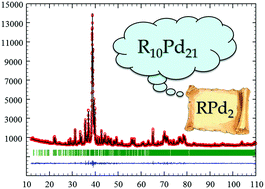The R10Pd21 compounds (R = Y, Pr, Nd, Sm, Gd–Lu). Crystal structure and magnetism of the ‘RPd2’ phases†‡
Abstract
We have investigated the formation and stability of the binary rare-earth phases, previously reported in the literature as “RPd2”. Although these phases apparently showed a simple stoichiometry, their structure was not that of a Laves phase. After more than half of a century their crystal structure and true stoichiometry have been finally established. The exact stoichiometry of the “RPd2” phases is R10Pd21. The formation of the R10Pd21 compounds has been ascertained for R = Y, Pr, Nd, Sm, Gd to Lu, including Yb; Sc does not form the 10 : 21 phase. Pr10Pd21 forms only as a high temperature phase. These compounds crystallize in the monoclinic Sm10Pd21-type (mS124-C2/m, No. 12, Z = 4); the lattice parameters and unit cell volume decrease linearly on going from Pr to Lu in agreement with the lanthanide contraction. The crystal structure has been determined by X-ray powder diffraction and refined by Rietveld method for the Y, Nd, Tb and Lu compounds. These phases form by a peritectic reaction; the formation temperature, Tf, of some of them has also been measured and compared with the values reported for the “RPd2” phases for which the literature data are available. The increase of both the volume contraction and Tf on going from Pr10Pd21 to Lu10Pd21 suggests an increase of the thermodynamic stability along the series from the lighter to the heavier R. Physical properties (heat capacity, magnetic susceptibility and magnetization, electrical resistivity and magnetoresistance) have been measured for some members of the series (Nd10Pd21, Gd10Pd21, Tb10Pd21, Dy10Pd21, Ho10Pd21, Lu10Pd21 and Y10Pd21). Antiferromagnetic ordering is found for compounds with magnetic R ions at low temperature; the highest Néel temperature, TN, is 10 K for Tb10Pd21. The present experimental work represents a valuable contribution towards a more complete knowledge of the R–Pd systems. In the light of these results, all the binary R–Pd phase diagrams have to be reinvestigated (mainly those based on data assessed by the CALPHAD technique, using optimized thermodynamic parameters) and updated to furnish the material scientists consistent information to challenge the study of more complex systems.



 Please wait while we load your content...
Please wait while we load your content...